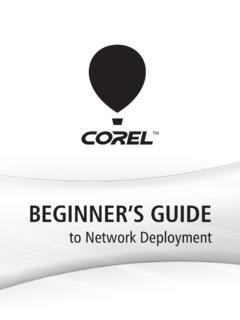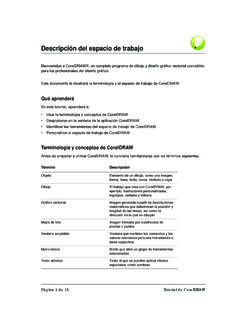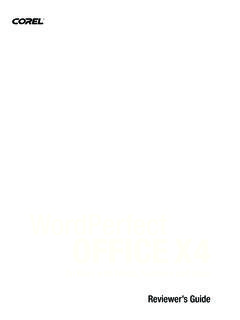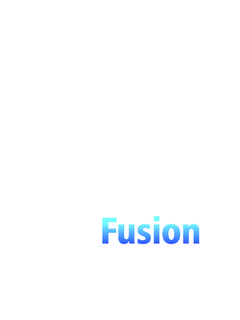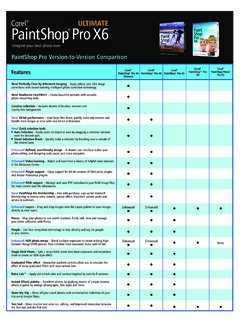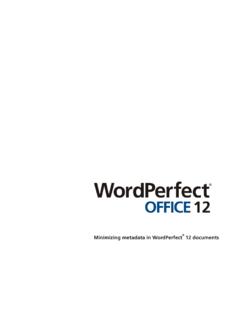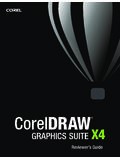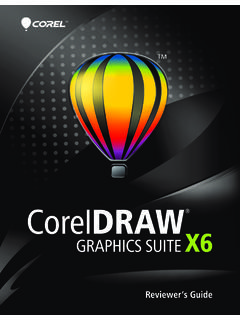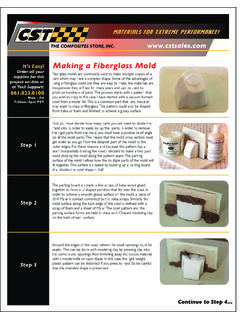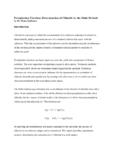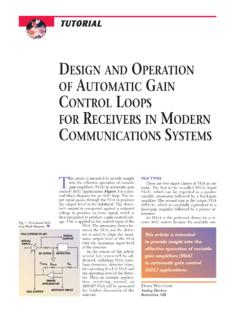Transcription of Workspace tour - Corel
1 Page 1 of 14 CorelDRAW tutorialWorkspace tourWelcome to CorelDRAW , a comprehensive vector-based drawing and graphic-design program for the graphics this tutorial, you will become familiar with the terminology and Workspace of you will learnIn this tutorial, you will learn how to use CorelDRAW terminology and concepts navigate the CorelDRAW application window identify the CorelDRAW Workspace tools customize the CorelDRAW workspaceCorelDRAW terminology and conceptsBefore you get started with CorelDRAW, you should be familiar with the following element in a drawing, such as an image, shape, line, text, curve, symbol, or layerdrawingThe work you create in CorelDRAW: for example, custom artwork, logos, posters, and newslettersvector graphicAn image generated from mathematical descriptions that determine the position, length, and direction in which lines are drawnbitmapAn image composed of grids of pixels or dotsdockerA window containing commands and settings relevant to a specific tool or taskflyoutA button that opens a group of related toolsartistic textA type of text to which you can apply special effects, such as shadowsTutorial: Workspace tourPage 2 of 14 CorelDRAW tutorialCorelDRAW application windowWhen you launch CorelDRAW, the application window opens containing a drawing window.
2 The rectangle in the center of the drawing window is the drawing page where you create your drawing. Although more than one drawing window can be opened, you can apply commands to the active drawing window application window contains the following main parts:paragraph textA type of text to which you can apply formatting options, and which can be edited in large blocksPartDescriptionMenu barThe area containing drop-down menus with commands grouped by categoryProperty barA detachable bar with commands that relate to the active tool or object. For example, when the Text tool is active, the text property bar displays commands that let you create and edit barToolboxNavigatorColor paletteDockerToolbar (standard)Property barMenu barDocument navigatorStatus barDrawing windowDrawing pageRulerTutorial: Workspace tourPage 3 of 14 CorelDRAW tutorialCorelDRAW Workspace toolsApplication commands are accessible through the menu bar, toolbars, property bar, dockers, and toolbox.
3 The property bar and dockers provide access to commands that relate to the active tool or current task. The property bar, dockers, toolbars, and toolbox can be opened, closed, and moved around your screen at any detachable bar that contains shortcuts to menu and other commands. The standard toolbar contains shortcuts to basic commands, such as opening, saving, and barThe area displaying the title of the currently open drawingRulersHorizontal and vertical borders that are used to determine the size and position of objects in a drawingToolboxA detachable bar with tools for creating, filling, and modifying objects in the drawingDrawing windowThe area outside the drawing page bordered by the scroll bars and application controlsDrawing pageThe rectangular area inside the drawing window. It is the printable area of your work paletteA detachable bar that contains color swatchesDockerA window containing commands and settings relevant to a specific tool or taskStatus barAn area at the bottom of the application window that contains information about object properties such as type, size, color, fill, and resolution.
4 The status bar also shows the current mouse navigatorThe area at the bottom left of the application window that contains controls for moving between pages and adding pagesNavigatorA button at the lower-right corner of the drawing window that opens a smaller display to help you move around a drawingPartDescriptionTutorial: Workspace tourPage 4 of 14 CorelDRAW tutorialToolbarsToolbars consist of buttons that are shortcuts to menu commands. The standard toolbar, which appears by default, consists of commonly used commands. The table below outlines the buttons on the standard addition to the standard toolbar, CorelDRAW has toolbars for specific kinds of tasks. For example, the Text toolbar contains commands relevant to using the Text tool. If you use a toolbar frequently, you can display it in the Workspace at all following table describes toolbars other than the standard this buttonTo Start a new drawing Open a drawing Save a drawing Print a drawing Cut selected objects to the Clipboard Copy selected objects to the Clipboard Paste the Clipboard contents into a drawing Undo an action Restore an action that was undone Import a drawing Export a drawing Start Corel applications Access the Corel Graphics Community Web site Set a zoom levelTutorial: Workspace tourPage 5 of 14 CorelDRAW tutorialProperty barThe property bar displays the most commonly used functions that are relevant to the active tool or to the task you re performing.
5 Although it looks like a toolbar, the property bar has content that changes depending on the tool or example, when you click the Text tool in the toolbox, the property bar displays only text-related commands. In the example below, the property bar displays text formatting, alignment, and editing display the same types of controls as a dialog box, such as command buttons, options, and list boxes. Unlike most dialog boxes, you can keep dockers open while working on a document, so you can readily access the commands to experiment with different ! ToolbarLets you access services on , such as Calendar and Mail, and use Yahoo! Search to search the Web. You need an Internet connection to use the Yahoo! commands for formatting and aligning textZoomContains commands for zooming in and out of the drawing page by specifying a percentage of the original view, clicking the Zoom tool, or selecting a page viewInternetContains commands for Web-related tools for creating rollovers and publishing to the InternetPrint mergeContains commands for print merge items that combine text with a drawing, such as creating and loading data files, creating data fields for variable text, and inserting print merge fieldsTransformContains commands for skewing, rotating, and mirroring objectsVisual Basic for ApplicationsContains commands for editing, testing, and running VBA commandsTutorial: Workspace tourPage 6 of 14 CorelDRAW tutorialDockers can be either docked or floating.
6 Docking a docker attaches it to the edge of the application window. Undocking a docker detaches it from the edge of the application window, so it can be easily moved around. You can also collapse dockers to save screen space. If you open several dockers, they usually appear nested, with only one docker fully displayed. You can quickly display a docker hidden from view by clicking the docker s : Docked and nested dockers. Right: A floating docker. To dock a floating docker, click the docker s title bar, and drag to position the pointer on the edge of the drawing window. To close a docker, click the X button at the upper-right corner; to collapse or expand a docker, click the arrow button at the upper-right example is the Object properties docker. When this docker is open, you can click an object in the drawing window and view the properties of the object, such as fill, outline, and : Workspace tourPage 7 of 14 CorelDRAW tutorialStatus barThe status bar displays information about selected objects, such as color, fill type, outline, cursor position, and relevant paletteA color palette is a collection of color swatches.
7 You can choose fill and outline colors by using the default color palette, which contains 99 colors from the CMYK color model. The selected fill and outline colors appear in the color swatches on the status bar. The following table describes how to choose a color from the default color toolbox contains tools for editing, creating, and viewing images. Some of the tools are visible by default, while others are grouped in flyouts. Flyouts open to display a set of related tools. A small arrow in the lower-right corner of a toolbox button indicates a flyout: for example, the Shape edit flyout . Clicking a flyout arrow opens a set of related tools. Clicking and dragging the grab handles at the end of the flyout sets the flyout in its expanded following tables provide descriptions of the flyouts and tools in the CorelDRAW the followingChoose a fill color for a selected object Click a color an outline color for a selected objectRight-click a color from different shades of a colorClick and hold a color swatch to display a pop-up color picker, and click a color.
8 View more colors in the default color paletteClick the scroll arrows at the top and bottom of the color edit Lets you access the Shape, Smudge brush, Roughen brush, and Free transform toolsCrop tool Lets you access the Crop, Knife, Eraser, and Virtual segment delete toolsZoom Lets you access the Zoom and Hand toolsCurve Lets you access the Freehand, B zier, Artistic media, Pen, Polyline, 3 point curve, Interactive connector, and Dimension toolsTutorial: Workspace tourPage 8 of 14 CorelDRAW tutorialSmart tools Lets you access the Smart fill and Smart drawing toolsRectangle Lets you access the Rectangle and 3 point rectangle toolsEllipse Lets you access the Ellipse and 3 point ellipse toolsObject Lets you access the Polygon, Star, Complex Star, Graph paper, and Spiral toolsPerfect Shapes Lets you access the Basic shapes, Arrow shapes, Flowchart shapes, Banner shapes, and Callout shapes toolsInteractive tools Lets you access the Interactive blend, Interactive contour, Interactive distortion, Interactive drop shadow, Interactive envelope, Interactive extrude, and Interactive transparency toolsEyedropper Lets you access the Eyedropper and Paintbucket toolsOutline Lets you access the Outline pen and Outline color dialog boxes, a selection of outlines of various widths.
9 And the Color dockerFill Lets you access the Fill color, Fountain fill, Pattern fill, Texture fill, and PostScript fill dialog boxes, and the Color dockerInteractive fill Lets you access the Interactive fill and Interactive mesh fill toolsToolDescription The Pick tool lets you select and size, skew, and rotate objects. The Shape tool lets you edit the shape of objects. The Smudge brush tool lets you distort a vector object by dragging along its outline. The Roughen brush tool lets you distort the outline of a vector object by dragging along the : Workspace tourPage 9 of 14 CorelDRAW tutorial The Free transform tool lets you transform an object by using the Free rotation, Angle rotation, Scale, and Skew tools. The Crop tool lets you remove unwanted areas in objects. The Knife tool lets you cut through objects. The Eraser tool lets you remove areas of your drawing.
10 The Virtual segment delete tool lets you delete portions of objects that are between intersections. The Zoom tool lets you change the magnification level in the drawing window. The Hand tool lets you control which part of the drawing is visible in the drawing window. The Freehand tool lets you draw single line segments and curves. The B zier tool lets you draw curves one segment at a time. The Artistic media tool provides access to the Brush, Sprayer, Calligraphic, and Pressure tools. The Pen tool lets you draw curves one segment at a time. The Polyline tool lets you draw lines and curves in preview mode. The 3 point curve tool lets you draw a curve by defining the start, end, and center points. The Interactive connector tool lets you join two objects with a line. The Dimension tool lets you draw vertical, horizontal, slanted, or angular dimension Smart fill tool lets you create objects from enclosed areas and then apply a fill to those : Workspace tourPage 10 of 14 CorelDRAW tutorial The Smart drawing tool converts the freehand strokes that you draw to basic shapes and smoothed curves.
